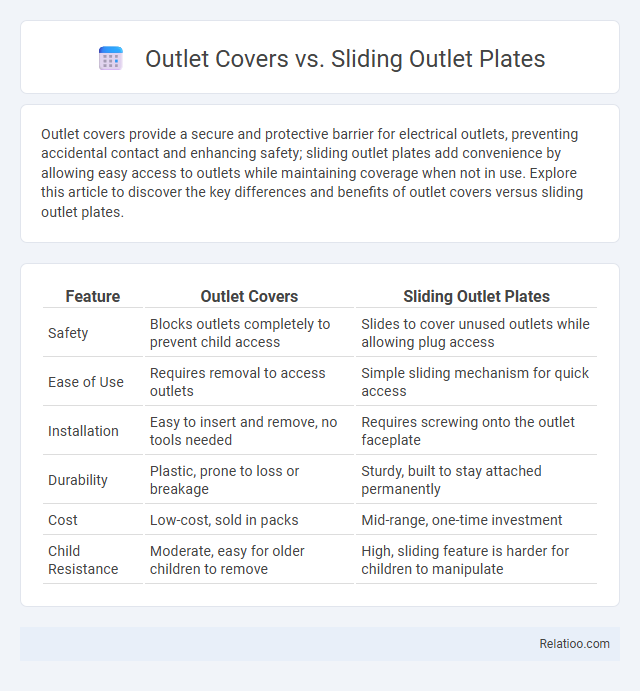Outlet covers provide a secure and protective barrier for electrical outlets, preventing accidental contact and enhancing safety; sliding outlet plates add convenience by allowing easy access to outlets while maintaining coverage when not in use. Explore this article to discover the key differences and benefits of outlet covers versus sliding outlet plates.
Table of Comparison
| Feature | Outlet Covers | Sliding Outlet Plates |
|---|---|---|
| Safety | Blocks outlets completely to prevent child access | Slides to cover unused outlets while allowing plug access |
| Ease of Use | Requires removal to access outlets | Simple sliding mechanism for quick access |
| Installation | Easy to insert and remove, no tools needed | Requires screwing onto the outlet faceplate |
| Durability | Plastic, prone to loss or breakage | Sturdy, built to stay attached permanently |
| Cost | Low-cost, sold in packs | Mid-range, one-time investment |
| Child Resistance | Moderate, easy for older children to remove | High, sliding feature is harder for children to manipulate |
Introduction to Outlet Safety Solutions
Outlet covers, sliding outlet plates, and childproofing devices each provide unique safety solutions to prevent electrical hazards. Sliding outlet plates automatically cover the receptacle when not in use, offering a seamless barrier against accidental contact, whereas traditional outlet covers require manual placement over the socket. Prioritizing your home's safety involves choosing the right outlet protection that combines ease of use with effective prevention of electrical shocks and injuries.
What Are Standard Outlet Covers?
Standard outlet covers serve as protective barriers designed to cover electrical outlets, preventing accidental contact with live electrical parts. These covers typically consist of a plastic or metal plate that snaps or screws over the outlet, offering basic protection without impeding outlet use. Your choice between standard outlet covers, sliding outlet plates, or specialized childproofing devices depends on the level of safety you require, especially in homes with young children.
Understanding Sliding Outlet Plates
Sliding outlet plates provide an effective childproofing solution by covering electrical outlets with a movable cover that automatically closes when the plug is removed, preventing direct access to live sockets. Unlike traditional outlet covers that must be manually inserted or removed, sliding plates offer convenience and consistent protection without impeding normal use of electrical devices. This design enhances safety by reducing the risk of electrical shock, making them a preferred choice for families seeking continuous outlet protection.
Key Features Comparison
Outlet covers provide a simple barrier to prevent direct contact with electrical sockets, often designed for easy removal by adults but secure against children. Sliding outlet plates offer a built-in safety mechanism with a sliding cover that automatically closes when the outlet is not in use, combining convenience and enhanced protection. Childproofing solutions focus on advanced safety features like tamper-resistant inserts or locking mechanisms to fully block access to electrical outlets, prioritizing maximum child safety.
Safety Benefits for Families
Outlet covers, sliding outlet plates, and childproofing devices all play critical roles in enhancing electrical safety for families by preventing accidental contact with live electrical sockets. Sliding outlet plates automatically cover the socket when not in use, offering a convenient and reliable barrier that reduces the risk of electrical shock without needing to remove covers manually. Prioritizing Your home's electrical outlet safety with these solutions significantly lowers the chance of injury, providing peace of mind and a safer environment for children.
Installation Process and Difficulty
Outlet covers are designed for quick and simple installation by snapping directly onto existing outlets, requiring minimal effort or tools. Sliding outlet plates offer enhanced childproofing by automatically covering the socket when not in use, but their installation involves carefully aligning the sliding mechanism, which may demand moderate DIY skills. Your choice depends on balancing ease of installation with the level of child safety; outlet covers are the easiest to install, while sliding outlet plates provide more security but slightly increased complexity.
Maintenance and Durability
Outlet covers made of durable plastic are easy to clean and maintain but may crack over time with frequent use. Sliding outlet plates offer enhanced childproofing by covering sockets completely and feature a mechanism that reduces wear, resulting in longer durability and minimal maintenance. Both options provide safety, but sliding plates require less frequent replacement due to their sturdy construction and protective design.
Aesthetic and Design Options
Outlet covers, sliding outlet plates, and childproofing solutions offer varying aesthetic and design options to enhance home interiors. Outlet covers come in diverse materials, colors, and finishes, providing seamless blending with wall colors or decor styles, while sliding outlet plates feature a sleek, retractable design that keeps outlets concealed when not in use, maintaining a clean and modern look. Childproofing options prioritize safety but now include stylish designs and low-profile forms that minimize visual disruption, ensuring functional protection without compromising interior aesthetics.
Cost Analysis: Outlet Covers vs Sliding Plates
Outlet covers typically cost between $5 and $15 per pack, offering a budget-friendly solution for childproofing electrical outlets. Sliding outlet plates, priced higher at approximately $10 to $25 each, provide enhanced safety by automatically covering unused outlets without constant manual intervention. Your choice depends on balancing initial expenses with convenience and long-term effectiveness in protecting children from electrical hazards.
Choosing the Right Option for Your Home
Choosing the right outlet protection for your home involves understanding the differences between outlet covers, sliding outlet plates, and childproofing devices. Outlet covers are simple plugs that prevent access to electrical sockets, while sliding outlet plates offer a built-in safety feature that automatically covers the socket when not in use. Your choice should balance ease of use, safety level, and compatibility with your outlet style to ensure effective childproofing without compromising convenience.

Infographic: Outlet Covers vs Sliding Outlet Plates
 relatioo.com
relatioo.com